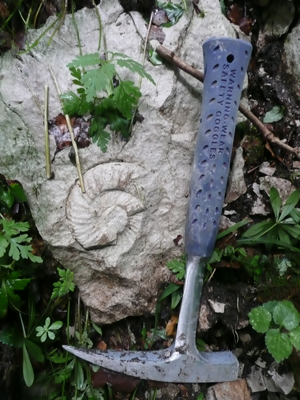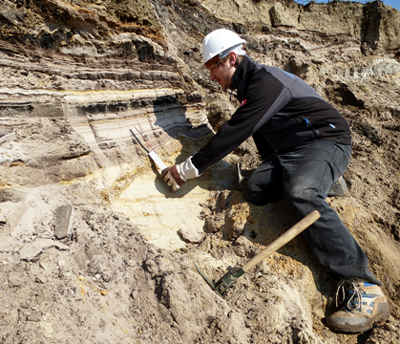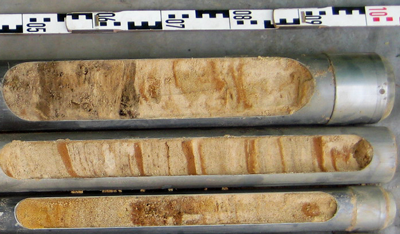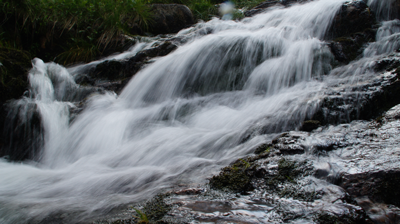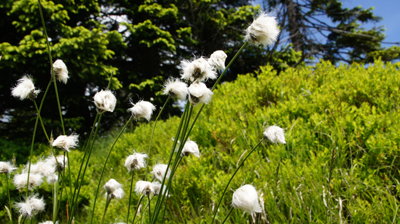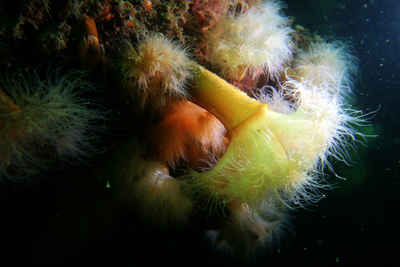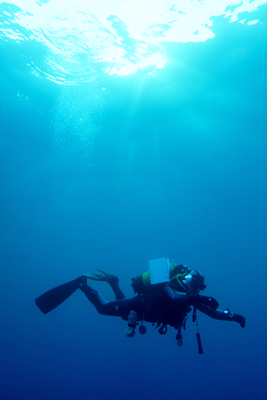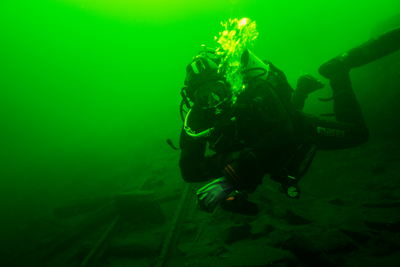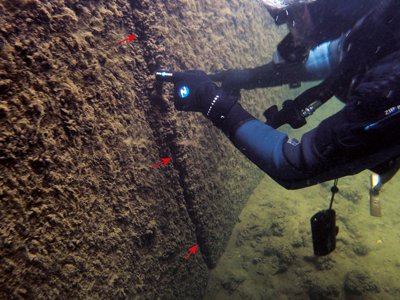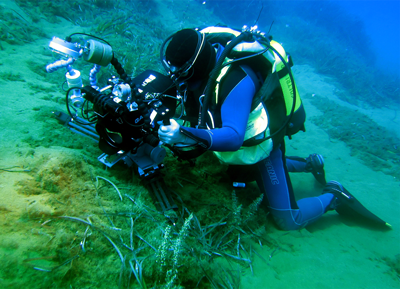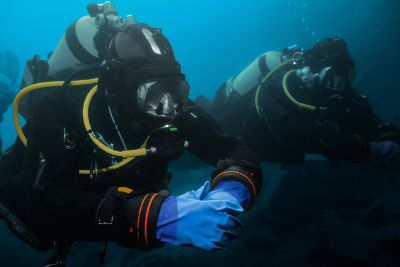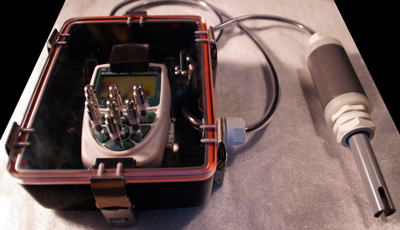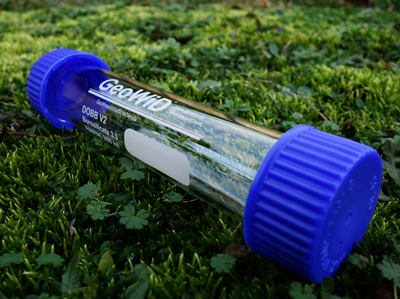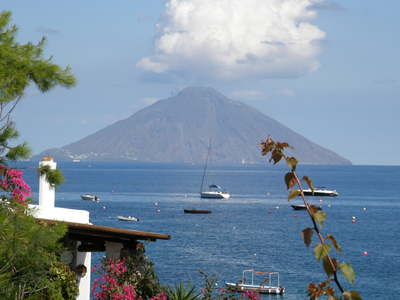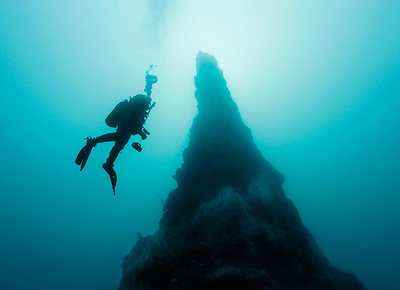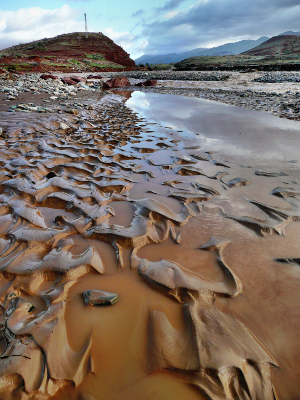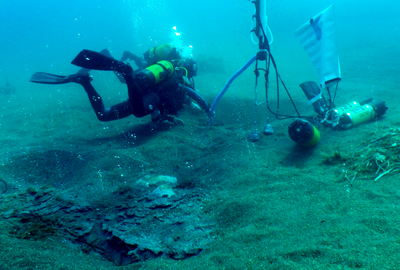Consulting
Earth Sciences
Geo Scientific Services
Classical geological and geotechnical tasks are the characterization and classification of soil and sediments as well as their evaluation in a variety of (legal) contexts. This is mostly needed in the context of waste declaration and recycling (contaminated sites/brownfields, soil management) or for engineering tasks required for foundations. We perform all necessary field and lab experiments and can provide you with an expert inspection. In addition, we offer construction measures surveillance as an independent inspector within the framework of self and external monitoring.
Geologic Mapping and Documentation
We tackle the complexity of geologic maps with an interdisciplinary approach. The typical geological tasks include strike and dip mapping, the recording of topography/morphology as well as the analysis of drilling samples and geophysical measurements. In addition, we utilize mapping procedures in the fields of biology and ecology. The focus here are the recording of species population and migration together with ecochemical analysis.
Documentation is the basis of all scientific work. Our abilities range from technical documentation for evidence collection and documentation of exploratory projects via photography and video to documentation of an unusual or special kind. For this purpose, we work closely with our partners from different disciplines of visual media.
Execution, Support and Organisation of Sampling Campaigns
We perform all kinds of samplings (soil, rock, water, gas, biomes), adjusted to the specific problem (e.g. Contaminated sites/brow fields, chemical analysis, geotechnical laboratory exploration) and in consideration of the required quality of the samples. We would be happy to discuss with you any options and methods suitable for your needs. Of cause, we can also assist you with scientific advice during any of your own sampling campaigns or aid you in organisational matters or regarding planning tasks.
Consulting
Environmental Sciences
The fields of earth and environmental sciences are closely connected and show many parallels in their methodology. However, it is important to differentiate between the focus points of the scientific work in these fields. For us ecosystems and their dynamics are paramount in environmental sciences. Our range of offers includes working with aquatic as well as terrestrial systems. Thereby, our methods are not limited to work above the water surface, but are unrestricted, since we utilise Scientific Divers (cf. Scientific Diving - LINK).
Sampling, Mapping, Monitoring
The qualitative and quantitative characterisation of water bodies, the evaluation of water quality as well as long-term monitoring of the evolution of ecosystems are all at the core of our work.
Thematic mapping and analysis, together with the monitoring of biological populations are all additions to our range of services. Of course, all our work complies with the requirements of the respective guidelines (water framework directive, ...).
Scientific Diving
Scientific Services
Scientific Diving is the application of scientific methods by specially trained scientists under water. At its core, it is the transfer of established exploration procedures and expertise to the medium of water which traditionally is awkward and hard to control for humans. Our interdisciplinary approach includes fundamental questions from the field of earth sciences as well as biological and chemical methods.
By means of on-site explorations and the resulting proximity to the specimen we ensue drastic improvements in quality and quantity of the extrapolated data. Compared to selective approaches from above the surface we gain a comprehensive and detailed impression of the investigated area.
Simply put:
We directly see the exact spot which we analyse or take samples and measurements from.
Areas of Application
Recurring tasks for under water operations include mapping, sampling (soil, rock, water, gas, biomes), chemical and physical measurements (e.g. Temperature, pH, Eh) as well as monitoring of specimens and geochronological sampling. High quality documentation by means of photography and videos are the basis for further processing and analysis above the water.
We would be happy to offer you solutions to complex situations.
Qualification and Safety
Our Scientific Divers are by default certified by the world underwater federation CMAS. Depending on their individual training progress and field experience the divers are graduated as “CMAS Scientific Diver”, “CMAS Confirmed Scientific Diver” or “CMAS Scientific Diving Instructor”. These additional occupational trainings include, depending on the organisational branch, a theoretical and practical training over the course of several month and assessments of the trainee by means of several exams. They ensure safe and practice-oriented, scientific operations under water while following all usual quality assuring measures.
Our work always follows the highest safety standards. We follow special work instructions, developed in collaboration with universities, insurance providers and trade associations, to guarantee the safety of our staff for us and our customers. The applied measures range from objective risk analysis and mandatory comprehensive documentation to project or operation specific safety concepts.
Moreover, our staff visits additional educational courses and trainings on a regular basis, including non-diving subjects such as operations management or advanced life support training.
Your Advantage
By utilizing Scientific Divers we offer you a precise execution of a given task with high quality results which would not be obtainable in the same fashion from above the water’s surface. Since our engineers are working on site, they are able to make observations which they can utilise for their decision making, choice of methods and later evaluation. Our experience has shown how much the situation at the investigated site or the state of the specimen can differ from the circumstances expected by the client. For this reason, we work very closely with the contact person above the water, to ensure a clear and immediate communication based on a high-quality documentation by means of photos and videos.
Scientific Diving
Technical Services
Hydraulic Structure Inspection
In collaboration with the certified experts of our partner, DEKRA Industrial, we perform inspections on hydraulic structures. Our innovative concept enables us to provide an objective grading based on hard facts and numbers. This leads to structured and independent analysis and planning for a maintenance and servicing schedule. By comparing the individual gradings, we can compile a ranking which outlines and summarises the optimal course of action for the management.
We have presented our concept for the first time at the annual meeting of the ICOLD 2017 in Prague. Please find a related article of ours here.
Technical Documentation
The scientific methods for the creation of a comprehensible and comprehensive documentation often can also be applied to technical questions. Depending on the circumstances on location our integrated documentations can include technical drawings, scans or photo and video documentation. Under water we are the eyes of our clients - no matter what. Our goal is to inform our associate above the water in a quality, as if he had been at the location himself.
Construction Surveillance and Inspection
The construction sites of hydraulic structures such as dams are seldom subject to the usual bodies for construction auditing or self and third-party monitoring. In our experience, costly and time intensive reworking or repairs can be avoided from the start, when checks and documentation are executed consequently and are already in place during the early construction phases. This creates safety for both the executing contractor as well as the project owner.
In addition, the actual circumstances on site often differ significantly from the anticipated situation. The exploration of the area by Scientific Divers in earlier project phases provides more safety for the planning and allows for optimised budgeting.
Special Equipment
Underwater Measuring Techniques
In order to identify physical and chemical parameters (e.g. Temperature, redox potential, pH-Value) we adapt standardized measuring techniques for under water usage. For these, precision and handling are the main focus. In cooperation with our partners at BS-Kinetics we work on flexible solutions, which enhance the usability and efficiency Certain housings can for example be use for a whole line of products of some measuring equipment manufacturers . All our systems are robust, have been tested in extreme situations in the field and undergo constant development towards perfection.
Special Equipment
Sampling Instruments
For under water operations we have developed dedicated sampling devices for different fields of deployment and areas of focus. It is of utmost importance for us, that all techniques are proven to be robust and show flawless applicability in practice.
Our systems allow for rock sampling of disturbed and undisturbed samples of Depending on the task multiple approaches are possible.
For water samples we offer solutions for both mix and point samples, which enables the accurate extraction of certain water phases from another (e.g. Sources of contamination). We use sterilizable glass containers and can guarantee highest safety due to our specialized manufacturing methods.
For extraction of pure gas phases from gas vents and achieving the needed quality, which allows for further analysis (e.g. trace elements), we offer flexible system solutions. You can choose between different gas volumes for you samples, in order to better meet the requirements of you analysis.
You can find the exact specifications and an assortment of possible configurations in the Downloads section.
All our systems are custom made and can be adjusted flexibly to fit your needs. We would be happy to offer our advice and to send an you an individual offer.
Research
Topics
Geology of Submarine Hydrothermal Vents near Panarea, Italy
Volcanoes, hydrothermal systems and their respective ecosystem types occur worldwide and are characterised by very special and highly variable geological, ecological and pysicochemical parameters. The CMAS Scientific Diving Center at the TU Mining Academy in Freiberg therefore explores this volcanic system of Panarea since the year 2006. Since 2010 we are involved in these explorations regularly and support the project in the field of earth sciences.
The system is a unique example for an active, shallow marine extreme ecosystem and a natural laboratory for assessing a multitude of topics like ocean acidification, geothermal energy or ecosystem analysis.
Our work as Scientific Divers allows us to witness the formation of geological structures from up close. To harness this unique opportunity to its full potential we utilize interdisciplinary approaches. Our working groups combine geology, (micro) biology, hydrology and even material sciences as well as mechanical engineering.
Please find further information about this topic in the following publication LINK – Publications:
Stanulla, R., Pohl, T., Müller, C., Engel, J., Hoyer, M., Merkel, B. (2017a): Structural and mineralogical study of active and inactive hydrothermal ?uid discharges in Panarea, Italy. Environmental Earth Sciences, Vol. 76, pp. 404-430, 2017. DOI: 10.1007/s12665-017-6714-6.
Interdisciplinary Documentation of Hydrothermal Vents in Northern Iceland
Another exciting topic in our research activities are hydrothermal vents in northern Iceland. In comparison to the system close to Panarea, the system in the Akureyri fjord shows completely different environmental conditions. But we could still find and record an astounding amount of similarities.
The almost 45m high vents protrude vertically from the bottom of the ocean into the sub polar see. The discharging hydrothermal fluids are the reason for a constant precipitation at the outlets, which enables you to “watch” the vents grow.
After all, the strictly protected area still holds many unanswered questions. Future explorations will for example touch subjects like hydrodynamics and thermodynamics as well as ecosystem analysis.
Please find further information about this topic in the following publication LINK – Publications:
Stanulla, R., Stanulla, C., Pohl, T., Merkel, B. (2017b): Structural and mineralogical study of active hydrothermal fluid discharges at Strýtan hydrothermal chimney, Akureyri Bay, Eyjafjörður region, Iceland. Geothermal Energy, Vol. 5, pp. 8-19, 2017. DOI: 10.1186/s40517-017-0065-0.
External Link
Reconstruction of Paleorivers
River systems shape terrestrial environments significantly. Mountain ranges get eroded, materials get transported and reworked; the terrain becomes more balanced. The newly created sediments and rocks are a product of a highly complex formation history and at times offer an important resource potential. The analysis of fluvial sediments is an integral scientific branch, which we support during several subprojects. The focus of these are facies analysis, paleo milieus and geomorphology.
Research and Development for the Optimisation of Underwater Applications
As Scientific Divers there usually don’t exist mass-produced devices for our purposes. However, to operate on a high level of quality and speed, we rely on our in-house production (see specialized devices LINK). Many challenges we face can not be solved with minor adjustments to existing equipment, which is the reason, why we conduct R&D projects for optimization analyses and conceptualization of new devices.
In cooperation with the Institute of Drilling Engineering and Fluid Mining of the TU Mining Academy in Freiberg we developed a mobile airlift for Scientific Divers. This device serves the purpose of clearing or cleaning structures covered by sediments, mainly in sedimentological under water research or during technical documentations. The system was specifically designed for the needs of Scientific Divers. The completely self-sufficient design eliminates unwieldy tubes running to the surface and enables unrestricted mobility.
Please find further information about this topic in the following publication LINK – Publications:
:
Stanulla, R., Barth, G., Ganß, R., Reich, M., Merkel, B. (2016): Development of a mobile airlift pump for Scientific Divers and its application in sedimentological underwater research. Underwater Technology, Vol. 34, No. 1, pp. 39â�“43, 2016. DOI:10.3723/ut.34.039
Download
Research
Publications
peer-review
Stanulla, R.; Hartmann, C.; Adamek, J.; Schiller, U.; Scholz, A.; Scheytt, T. (2024): Forschungsprojekt zum Umgang mit Talsperrensedimenten am Beispiel einer Stauanlage der Revierwasserlaufanstalt Freiberg, Sachsen. In: WasserWirtschaft, Ausgabe 10/2024. Wiesbaden: Springer Vieweg, 2024
Stanulla, R.; Hein, S.; Adamek, J.; Schmutterer, C. (2024): Innovative Methoden der Bauwerksprüfung am Beispiel integrierter Untersuchungen an Stauanlagen der Talsperre Saidenbach. In: WasserWirtschaft, Ausgabe 10/2024. Wiesbaden: Springer Vieweg, 2024
Stanulla, R.; Schmelzer, K.; Hein, S. (2023): Bauwerksprüfung wasserbautechnischer Anlagen – handnahe Prüfung nach DIN 1076. In: WasserWirtschaft, Ausgabe 1/2023. Wiesbaden: Springer Vieweg, 2023.
Stanulla, R.; Schmelzer, K.; Hein, S. (2022): Bauwerksprüfung wasserbautechnischer Anlagen – handnahe Prüfung nach DIN 1076. In: Hochschule Mittweida - Wissenschaftliche Berichte, Ausgabe 1/2022: Messtechnische Überwachung von Stauanlagen. ISSN 1437-7624.
Stanulla, R. (2021): Geological and mineralogical investigation of hydrothermal fluid discharge features at the sea bottom of Panarea, Italy. Freiberg Online Geoscience (FOG), Vol 60, pp. 1-174. ISSN 1434-7512. Externer Link
Stanulla, R; Hein, S.; Pohl, T. (2020): Methoden und Einsatzgebiete Wissenschaftlicher Taucher. In: WasserWirtschaft, Ausgabe 1/2020. Wiesbaden: Springer Vieweg, 2020.
Hein, S. & Stanulla, R. (2020): Bauwerksprüfung durch Wissenschaftliche Taucher – handnahe Prüfung nach DIN 1 076. In: WasserWirtschaft, Ausgabe 1/2020. Wiesbaden: Springer Vieweg, 2020.
Lux, I.; Fiedler, D.; Salzmann, M.; Schmutterer, C.; Stanulla, R. (2019): Talsperre Lichtenberg: Erneuerung des Dichtungsanschlusses Asphaltaußen-dichtung / Komplexbauwerk unter Einstaubedingungen. WasserWirtschaft, Ausgabe 5/2019. Wiesbaden: Springer Vieweg.
Stanulla, R., Stanulla, C., Pohl, T., Merkel, B. (2017c): Structural and mineralogical study of active hydrothermal fluid discharges at Strýtan hydrothermal chimney, Akureyri Bay, Eyjafjörður region, Iceland. Geothermal Energy, Vol. 5, pp. 8-19, 2017. DOI: 10.1186/s40517-017-0065-0. Externer Link
Stanulla, R., Hein, S., Pohl, T., Grab, T., Ganß, R., Merkel, B. (2017b): Technical surveys of dams by Scientific Divers – in-situ investigations and their implication. Book of Abstracts of the Knowledge Based Dam Engineering Symposium. 85th ICOLD Annual Meeting International Symposium, p. 90. ISBN: 978-80-906662-2-1. Download (PDF)
Stanulla, R., Pohl, T., Müller, C., Engel, J., Hoyer, M., Merkel, B. (2017a): Structural and mineralogical study of active and inactive hydrothermal fluid discharges in Panarea, Italy. Environmental Earth Sciences, Vol. 76, pp. 404-430, 2017. DOI: 10.1007/s12665-017-6714-6. Externer Link
Müller, C., Zink, M., Samaniego, L., Krieg, R., Merz, R., Rode, M., Knöller, K. (2016): Discharge Driven Nitrogen Dynamics in a Mesoscale River Basin as Constrained by Stable Isotope Patterns. Environmental Science and Technology, DOI: 10.1021/acs.est.6b01057
Stanulla, R., Barth, G., Ganß, R., Reich, M., Merkel, B. (2016): Development of a mobile airlift pump for Scientific Divers and its application in sedimentological underwater research. Underwater Technology, Vol. 34, No. 1, pp. 39–43, 2016. DOI:10.3723/ut.34.039 Externer Link
Download (PDF)
Müller, C., Krieg, R., Merz, R., Knöller, K. (2015): Regional nitrogen dynamics in the TERENO Bode River catchment, Germany, as constrained by stable isotope patterns, Isotopes in Environmental and Health Studies. p. 1-14, DOI: 10.1080/10256016.2015.1019489
Tittel, J., Müller, C., Musolff, A., Schultze, M., Knöller, K. (2015): Fluvial radiocarbon and its temporal variability during contrasting hydrological conditions, Biogeochemistry. Vol 126, Issue 1, pp 57-69. DOI: 10.1007/s10533-015-0137-9
Pohl, T. et al. (2014): Discovery of a living coral reef in the coastal waters of Iraq. Sci. Rep. 4, 4250; DOI:10.1038/srep04250 (2014)
Fuhrland, M. & Weber, J. (2011): Problemzone Hochschulpatente. FORSCHUNG Politik – Strategie – Management. 3+4 2011. ISSN 1868 – 1654
Müller, C., Matschullat, J., Townsend, K. (2011): Experimental degradation of polymer shopping bags (standard and degradable plastic, and biodegradable) in the gastrointestinal fluids of sea turtles, Science of the Total Environment.
Müller, C. (2011): Geothermal state of shallow submarine geothermal systems and isotopic signatures of Panarea, Aeolian Islands (Italy). FOG 2011, Vol 30.
International and national scientific articles
Stanulla, R.; Hein, S.; Adamek, J.; Schmutterer, C. (2024): Innovative Methoden der Bauwerksprüfung am Beispiel integrierter Untersuchungen an Stauanlagen der Talsperre Saidenbach. 13. Mittweidaer Talsperrentag, April 2024.
Stanulla, R.; Hartmann, C.; Adamek, J.; Schiller, U.; Scholz, A.; Scheytt, T. (2024): Forschungsprojekt zum Umgang mit Talsperrensedimenten am Beispiel einer Stauanlage der Revierwasserlaufanstalt Freiberg, Sachsen. 13. Mittweidaer Talsperrentag, April 2024.
Adamek, J., Stanulla, R., Pohl, T. (2021): Large and small scale neotectonic structures in the submarine hydrothermal system of Panarea Island. 6th European Conference on Scientific Diving, Freiberg, Germany, June 2021.
Adamek, J., Stanulla, R., Pohl, T., Kürzinger, V. (2019): Geological and structural mapping of holocene small-scaled secondary subrosion structures at Area 26, Panarea, Italy. 5th European Conference on Scientific Diving, Sopot, Poland, April 2019.
Stanulla, R., Adamek, J., Pohl, T., Hein, S. (2019): Visual documentation as typical tool of applied scientific diving for standard testing procedures on barrages and other engineering constructions. 5th European Conference on Scientific Diving, Sopot, Poland, April 2019.
Stanulla, R., Kakuk, F., Pohl, T., Merkel, B. (2017): Geochemical and mineralogical investigations on hydrothermal lithologies in La Calcara, Panarea Island, Italy. 3rd European Conference on Scientific Diving, Funchal, Portugal, March 2017
Müller, C., Zink, M., Samaniego, L., Krieg, R., Rode, M., Merz, R., Knöller, K. (2016): Catchment scale limitations for nitrogen process recognition along a river system, Jesium 2016, Ghent University Belgium
Müller, C., Jogler, C., Hornburger, P., Rast, P., Müller, R-W., Knöller, K., Brümmer, F. (2016): Characterizing different ecological habitats in a meromictic alpine lake, 2nd European Conference on Scientific Diving 2016, University of Gothenburg, The Sven Lovén Centre for Marine Sciences
Müller, C., Zink, M., Krieg, R., Rode, M., Merz, R., Knöller, K. (2016): Isotopic investigation of the discharge driven nitrogen dynamics in a mesoscale river catchment, Vol. 18, EGU2016-12308, EGU General Assembly 2016
Stanulla, R., Ganß, R., Engel, J., Pohl, T., Merkel, B. (2016): Detailed mapping of small-scaled hydrothermal fluid escape structures at Area 26 and La Calcara, Panarea, Italy. 2nd European Conference on Scientific Diving, Kristineberg, Schweden, Mai 2016.
Müller, C., Merz, R., Zink, M., Krieg, R., Rode, M., Knöller, K. (2015): Discharge driven nitrogen dynamics in a large river catchment: an isotopic study, Integrates Project "Water and matter flux dynamics in catchments" Assembly 2015, 1st price Best Poster Award
Müller, C., Zink, M., Krieg, R., Rode, M., Merz, R., Knöller, K. (2015): Discharge driven nitrogen dynamics in a large river catchment: an isotopic study, Jahrestagung der Arbeitsgemeinschaft Stabile Isotope e.V. 2015, Heidelberg
Müller, C., Winkler, K., Maack, G., Barth, G., Frei, H., Freier, U., Knepel, G., Müller, R-W., Pohl, T., Brümmer, F. (2015): VDST Ressort Scientific Diving – Training of CMAS scientific divers, 1st European Conference on Scientific Diving, 2015 Stuttgart
Stanulla, R., Ganß, R., Pohl, T., Engel, J., Vinmans, A. (2015): In-situ-Methoden der Untersuchung bergbaulich beeinflusster Stehgewässer – Möglichkeiten und Einsatzgebiete Wissenschaftlicher Taucher. 66. Berg- und Hüttenmännischer Tag der TU Bergakademie Freiberg – Mine Water Symposium, Freiberg, Juni 2015. Externer Link (PDF)
Stanulla, R., Barth, G., Ganß, R., Merkel, B. (2015): Possibilities to gain scientific data underwater – approaches on robust and comparable measuring devices. Posterbeitrag. 1st European Conference on Scientific Diving, Stuttgart, März 2015.
Stanulla, R., Pohl, T., Ganß, R., Merkel, B. (2015): Geological sampling techniques for underwater research - an overview. 1st European Conference on Scientific Diving, Stuttgart, März 2015.
Tittel, J., Müller, C., Schultze, M., Knöller, K. (2015): Contemporary and ancient carbon mobilized in watersheds of different landuse and topography, 2015 Aquatic Science Meeting ASLO, Granada
Müller, C., Merz, R., Krieg, R., Knöller, K. (2014): Regional nitrogen dynamics in the Bode river system, Germany, as constrained by stable isotope patterns, Jahrestagung der Arbeitsgemeinschaft Stabile Isotope e.V., ASI 2014, Helmholtz-Zentrum München
Tittel, J., Müller, C., Schultze, M., Knöller, K. (2014): Die Quellen des terrestrischen Kohlenstoff-Exports in zwei Einzugsgebieten mit unterschiedlicher Landnutzung und Topographie, Jahrestagung der Deutschen Gesellschaft für Limnologie e.V. DGL und der Societas Internationalis Limnologiae SIL
Jäger, J., Müller, C., Merz, R., Krieg, R., Knöller, K. (2013): Einfluss der Raum-Zeit-Variabilität der Niederschlagsmenge und -zusammensetzung auf die großräumige Fließ- und Stoffdynamik im Einzugsgebiet der Bode, 2nd TERENO Workshop „Wasserisotope“ to the GFZ German Research Centre for Geosciences, GFZ Potsdam
Müller, C., Merz, R., Krieg, R., Knöller, K. (2013): Regionale Isotopenverteilungsmuster zur Betrachtung großskaliger Stoff- und Fließdynamiken des TERENO Bode Flusseinzugsgebietes, 2nd TERENO Workshop „Wasserisotope“ to the GFZ German Research Centre for Geosciences, GFZ Potsdam
Müller, C., Merz, R., Krieg, R., Knöller, K. (2013): Assessment of regional nitrogen dynamics in two European river catchments by stable isotope investigations, Isotope Workshop XII, European Society for Isotope Research (ESIR), Technische Universität Bergakademie Freiberg
Prautsch, A., Stanulla, R., Pohl, T., Merkel, B. (2013): Geochemical mineralogical investigation of degassing structures caused by recent volcanic hydrothermalism, La Calcara, Panarea (Italy). 3rd International Workshop “Research in Shallow Marine and Fresh Water Systems”, Bremen, Februar 2013. Download (PDF)
Sieland, R., Müller, C., Tichomirowa, M., Knöller, K., Schipek, M., Merkel, B. (2013): Geothermal activity as a key to the past: stable isotopes indicate the presence of Messinian evaporates in the submarine hydrothermal system of Panarea, Italy; Isotope Workshop XII, European Society for Isotope Research (ESIR), Technische Universität Bergakademie Freiberg
Stanulla, R., Ganß, R., Müller, C. (2013): GeoWissenschaftliche Dienste: Innovative Konzepte und Arbeitsmethoden für subaquatische Untersuchungen. Posterbeitrag. 64. Berg- und Hüttenmännischer Tag der TU Bergakademie Freiberg – Mine Water Symposium, Freiberg, Juni 2013.
Stanulla, R., Pohl, T., Merkel, B. (2013): Laminated mineral precipitates in gas and water escape structures from the shallow marine hydrothermal system in Panarea, Italy. 3rd International Workshop “Research in Shallow Marine and Fresh Water Systems”, Bremen, Februar 2013.
Müller, C., Merz, R., Krieg, R., Knöller, K. (2012): Investigation of Large Scale Hydrological and Hydrochemical Processes by Regional Isotope Patterns, American Geophysical Union (AGU), San Francisco
Müller, C., Sieland, R., Merkel, B., Knöller, K. (2012): Hydrothermal water exhalations at the submarine volcano Panarea, Italy – insights from stable isotope investigations, European Geosciences Union (EGU), Wien
Müller, C., Merz, R., Krieg, R., Knöller, K. (2012): Assessment of large scale hydrological and hydrochemical processes by means of regional Isotope patterns, Workshop der Kommission I “Bodenphysik und Bodenhydrologie der Deutschen Bodenkundlichen Gesellschaft, Helmholtz Zentrum für Umweltforschung UFZ Leipzig
Müller, C., Merz, R., Krieg, R., Knöller, K. (2012): Assessment of large scale hydrological and hydrochemical processes by means of regional Isotope patterns, Joint European Stable Isotope Users Group Meeting (Jesium), Helmholtz Zentrum für Umweltforschung UFZ Leipzig
Müller, C., Barth G, Merkel B (11/2011): Geothermal state of shallow submarine geothermal systems of Panarea, Aeolian Islands (Italy), 3rd International Symposium on Occupational Scientific Diving, Porto Cesareo, Lecce (Italien)
Müller, C., Sieland, R., Schipek, M., Italiano, F., Kummer, N-A., Merkel, B. (2011): Gas geochemistry at the submarine volcano Panarea, Italy – results from 2006 to 2011, 3rd International Symposium on Occupational Scientific Diving, Porto Cesareo, Lecce (Italien)
Stanulla, R. (2011): Scientific diving excursion Panarea 2011 - Geology. TU Bergakademie Freiberg.
Ganß, R. (2010): Scientific diving excursion Panarea 2010 - Geological / GPS mapping. TU Bergakademie Freiberg.
Pohl, T., Becke, R., Ganß, R., Stanulla, R., Merkel, B. (2010): Small Scale Recent Sulfide Mineralization in a Shallow Submarine Environment. In: F. Italiano (Hg.): Second international workshop on research in shallow marine and fresh water systems. Palermo, pp. 64–66.
Stanulla, R. (2010): Scientific diving excursion Panarea 2010 - Geological / GPS mapping. TU Bergakademie Freiberg.
